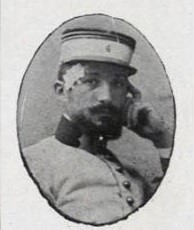Campaign History of the 151e Régiment d'Infanterie - V
~ 1915 ~
In the Argonne - Part I (15 January - 28 February)
Bois de la Gruerie - Fontaine-Madame Sector
With the start of the new year, the 151 is finally transferred from flooded fields of Flanders, where it had fought for over 2 months nearly without let up, in the finvaual throes of the war of movement. The regiment had suffered enormous losses. Some men who'd been wounded in the summer and fall had returned to the ranks. Many more replacements were new recruits from the class of '14, 19 and 20 year olds who'd been hurriedly pressed into service in the fall of 1914 after only a few weeks of training. For hundreds of men in the regiment, their baptism of fire would come in the chaotic labyrinth of the Argonne, in what would become the notorious Bois de la Gruerie sector (later nick-named Bois de la Tuerie -- "Slaughter Wood"). The fighting in the Argonne -- where tightly packed pines, thick vegetation, and a maze of steep ravines worked to reduce visibility and enhance the sense of claustrophobia -- had a signature all of its own. The fighting was relentless, with sudden raids, artillery bombardments, and grenade attacks. It was up close and personal. And underlying all of this, quite literally, a war of underground mines was being waged, each side detonating explosives under the foes' positions to gain the upper hand one small locality or another. The Argonne is where it could be said that the last vestiges of the 151 RI of 1914 would finally see its end, to be replaced by another evolution that would go on to fight in Champagne in the fall.
A note here about reinforcements coming to the regiment. Unfortunately, a precise figure of the regiment's effective does not appear in the JMO again after 5 August 1914. The exact figures of the regiment's losses cannot be gained exclusively from the JMO. For instance, the number of men evacuated due to illness is not recorded, and yet dozens had sent to the hospitals from congestion and trench foot. As it has been shown previously, the figures given for the number of reinforcements received cannot always be taken at face value either. In any case, by the 20 January, the total effective would reach its peak for the month at 46 officers and 2,732 men.

Lieut.-Colonel Ruef.
1-10 January: On 1 January, the regiment is at rest and Lieut-Colonel Ruef of 4 Tirailleurs is assigned to the 151. The next day the regiment marches off in three successive columns throughout the morning and afternoon to the Bailleul train station, where it embarks for Longueau for a long rest far from the front. Adjudant-Chefs Aubert and Rougélovitch are promoted to sous-lieutenant. On 3 January, after riding in trains overnight, the battalions debark at Longueau successively, with 1 Bat. being sent to Saint-Fuscien - Petit Gagny, and 2 and 3 Bats. to Sains-en-Amienois. From 4-6 January, the regiment is on rest. On 7 January a detachment of reinforcements arrives from the 151 depot composed 277 men, consisting of:
1 adjudant-chef
14 sergents
16 caporaux
127 veteran soldiers
119 new recruits
From 8-10 January, the regiment continues to be on rest and reorganize.
11-16 January: On 11 January the regiment is conducting some small maneuvers when it suddenly receives orders to embark in three groups to the Amiens train station. The first group (with Colonel Dillemann) leaves in the afternoon, consisting of the regimental staff, the out-of-ranks company, 1 through 6 Cos., a portion of the regiment's combat train, and some other support staff. The regiment arrives in Villers - Daucourt (Marne) [Villers-en-Argonne - Élise-Daucourt] in the afternoon and evening of 12 January, with 1 Bat. setting up at Bournaville and the regimental staff, 2 Bat. and 3 Bat. setting up at Ante (Marne). 13-14 January are spent making preparations to move to the regiment's new sector in the Bois de la Gruerie (northeast of Vienne-le-Château - La Harazée), in the Argonne Forest. The regiment is also informed of its assignment to its new army corps, 32 CA (composed of 40 DI and 42 DI).
On 15 January, Colonel Dillemann is provided information on the regiment's future sub-sector, Fontaine-Madame (Fontaine de Madame). To the regiment's left will be the 40 DI and to its right, the 162 RI. In the evening a reinforcement of officers arrives comprised of 16 sous-lieutenants (provided from the École Normale Supérieure and candidates from Saint-Cyr), followed several hours later by a detachment of replacements of 213 men. The detachments, divvied up amongst the companies, consist of:
13 candidates from Saint-Cyr.
3 cadets from École Normale Supérieure.
1 adjudant
4 sergents
7 caporaux
48 veteran soldiers
153 new recruits (coming from the 107 RI depot at Angoulême in Charente).
One of those coming from Saint-Cyr was Sous-Lieutenant Roger Campana, who was assigned to 5 Co. commanded by Lieutenant Sainte-Croix. A portion of his first-hand account can be found here. Sous-Lieut. Roger Basteau was another among them, who is assigned to 7 Co. under Capt. Carré.
In the morning of 16 January, the regiment is transported by automobiles near Ante (intersection 500 meters east of Sivry-sur-Ante) to La Neuville-au-Pont, 17 km north, except for 80 men [from 4 Co.] who could not fit. These men will cover the distance on foot via Sainte-Menehould and Vienne-la-Ville. From La Neuville-aux-Bois, where the first elements debark in automobiles around noon, 2 Bat. debarks in the first vehicles in the direction of La Harazée, 1 and 3 Bats. to Florent [-en-Argonne]. At the same time, another detachment of replacements debarks at Givry-en-Argonne 201 men, composed of:
1 adjudant-chef
8 sergents
16 caporaux
50 veteran soldiers
126 new soldiers (coming from the depot of 50 RI at Périgueux in Dordogne)
Four views of the town of Florent [-en-Argonne].
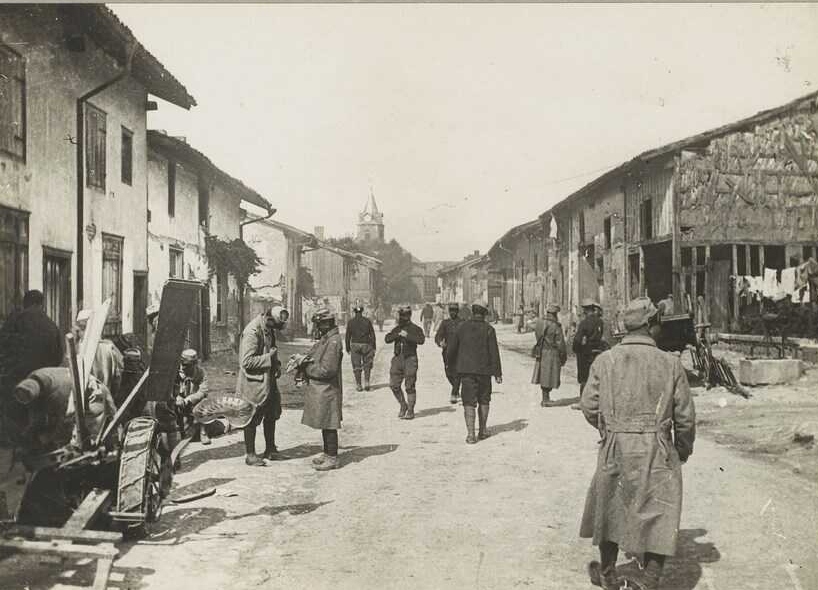
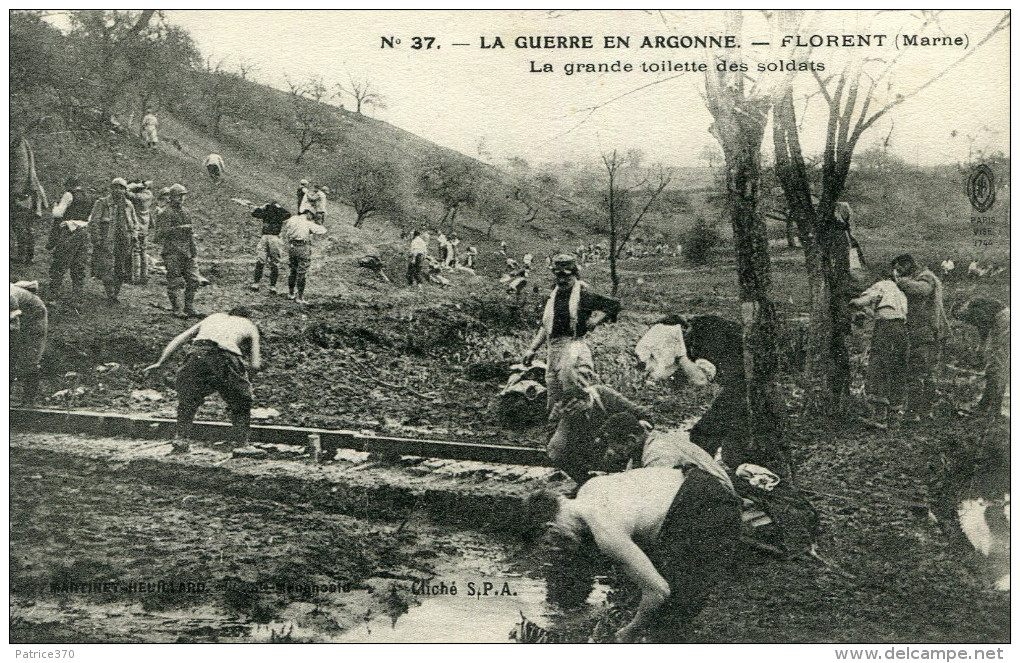


17 January: 2 Bat., having arrived the day before, spends the night at La Harazée along with the regimental-staff. At 1100 hrs, 1 Bat. arrives at the village. 2 Bat. goes up to the front lines and relieves 2 Bat/147 RI and 1 Bat/120 RI in the Fontaine-Madame sector.
1 Bat. goes into position in the right sub-sector with 1 and 2 MG Sections in the order of: 1, 3, 2 Cos. in the first line; 4 co. in the second line to the right and left.
There are two points in this sector that are precarious. One is the hillock called Blanleuil (Blanloeil) with a portion of the works already taken by the Germans. The other are the trenches occupied by 3 Co. (Capitaine Pornet) called "Enfants-Perdus" (Lost-Children), which front to the north and which are isolated and impossible to support, according to Sous-Lieut. Rougelovitch.
2 Bat. takes up positions in the left sub-sector with 4 MG Section in the order of: 7, 8, 6, 5 Cos. In this sub-sector there are likewise two precarious points: the trenches occupied by 7 Co. (Capitaine Carré) in the bottom of the valley, and to the right of the sub-sector where the Germans have a listening post only 10 meters away.

Capt. Carré in 1914.
At noon 3 Bat. arrives at La Harazée, followed by a detachment that arrived in evening before at Florent, along with four officers transferred from other units. 3 Bat. billets at the village and is assigned the role of ready-reserve and close support. Colonel Dillemann and his staff take command of the PC of the Fontaine-Madame sector. After being relieved in the first line, a company of the 147 RI occupies the third line, along with a machine-gun section of the 147. The detachment of replacements is split into twelve groups, four of which are incorporated into four companies of 3 Bat. The remaining eight remain in place so as to be incorporated ultimately into 1 and 2 Bats. [presumably because these two units were already deployed in the trenches]. The four officer-transfers are:
Lieutenant Trouillier of the 5 RI - takes command of 10 Co.
Lieutenant Népote of the 39 RI - takes command of 11 Co.
Sous-Lieutenant Berteau of the 123 RI - assigned to 11 Co.
Sous-Lieutenant Meslier of the 123 RI - assigned to 10 Co.
For a closer view of what conditions were like on the ground, we turn to Sous-Lieutenant Campana's account. Campana had arrived at La Neuville-au-Pont in the early evening where he heard for the first time shots fired in anger. To him it sounded like:
"...a low rumbling almost like a distant storm. Gradually, it increased in volume and the sound changed to a serious rolling noise that was akin to heavy carts bouncing along paved streets. The detonations seemed to reverberate a hundred times over and over. Then the rolling sound became louder, more resonate, more harrowing. Suddenly the whole scene came into view. Against the gray sky little white puffs that looked for all the world like snowflakes: shrapnel shell bursts."As Campana passed through the ruined village of Vienne-le-Château night began to fall. All around, the ground was pocked with shell-holes. The walls in the village had been cut down by shell-fire. On either side there were up-turned caissons and splintered trees, which lined the road like ghosts, as the winding Biesme, overflowing its banks, sinisterly reflected the pale fading light of dusk. The cannonade grew louder now. The individual detonations of the shells could now be clearly distinguished, followed by a quick stab of light that lit up the sky. A heavy downpour began, creating a more dismal mood. Maintaining silence, Campana and his troops entered the first trenches 2 km from the village. Occasional illumination flares lit up the dark shadows around him, casting a bloody iridescence across the trembling heights and the serrated saplings.
"The floor of the trench consisted of a thick, sticky mud that made progress laborious. Stray bullets whistled overhead or burrowed into the trees around us with a sharp crack. Occasionally a time shell burst in the woods, the sound of its explosion reverberating between the steep ravines like a big thunderclap. We are passed by stretcher-bearers heading back down the line carrying dead men on their stretchers, sending a chill down the spine."After waiting two hours under the chilly rain for a guide to bring his men into line, they once again move forward. Progress is difficult in the inky darkness as the men stumble into felled tree trunks and shell-holes full of icy water. Eventually, he arrives at a covered trench where he relieves a section of the 147 RI.
Map of Bois de la Gruerie in the Argonne Forest, with key located in top right corner. Map on right provides more detail of Fontaine-Madame sector.
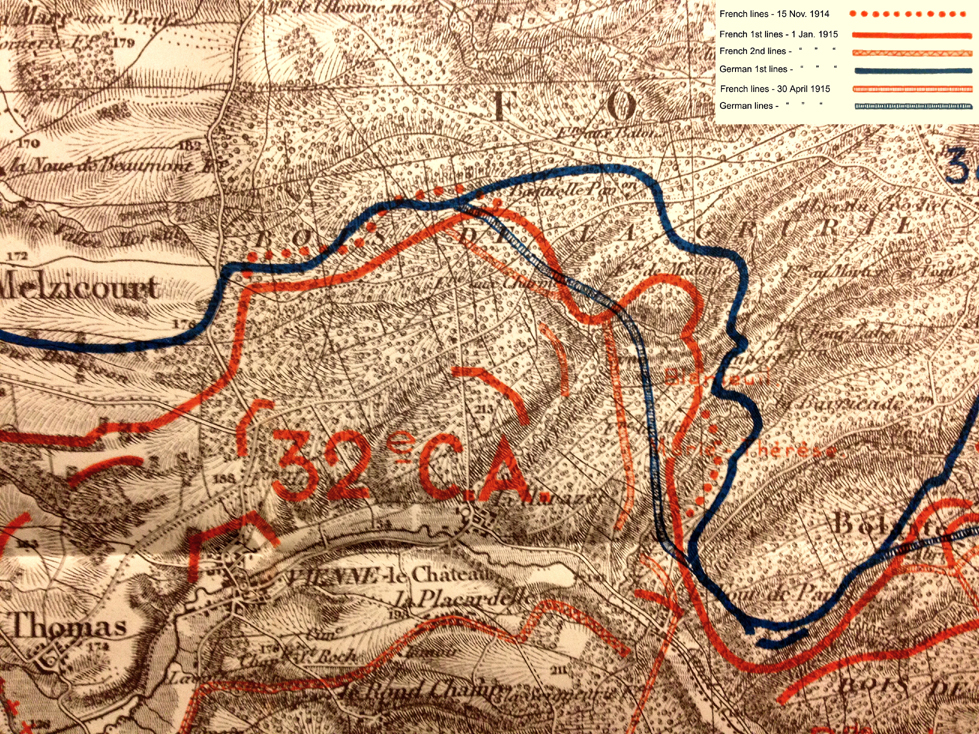
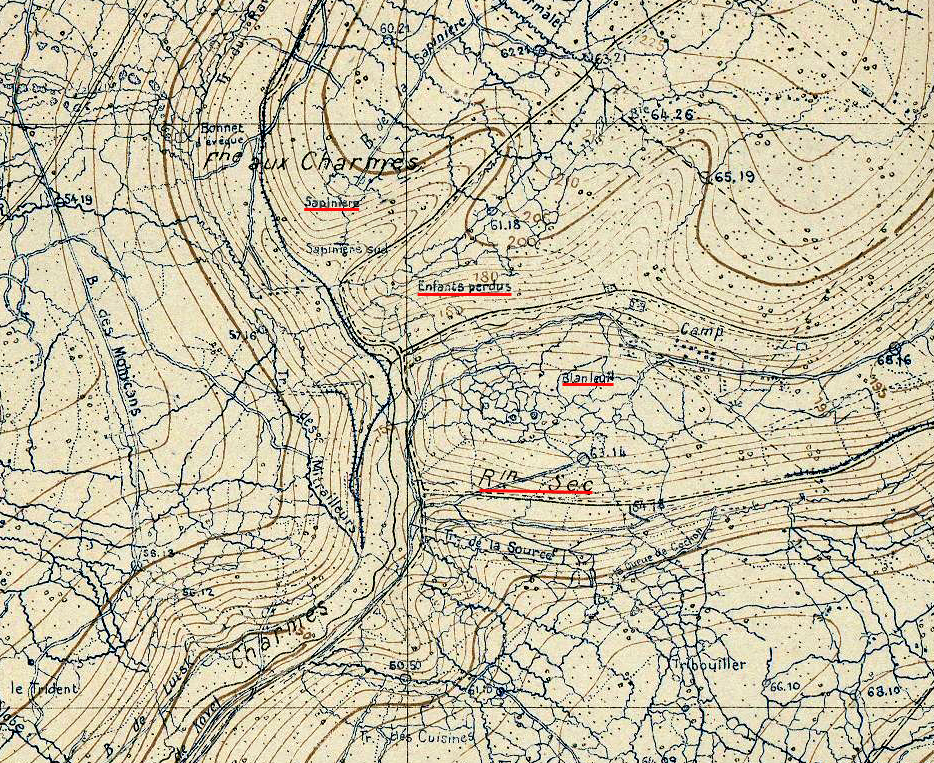
18 January: Temperatures had fallen throughout the evening and by morning the rain changed into snow. 9 Co. (under Sous-Lieutenant Teysserenc [sic - Teisserenc]) is sent up to relieve the company of the 147 RI still position in the third line and the 3 Machine-Gun Section relieves the section of the 147 RI. The 9 Co. has two sections placed in the second line on the right (north) bank of the stream [Fontaine aux Charmes], another section and half-section in the third line on the same bank, and a half-section in the fourth line (detached in an observation post). The 4 Co. moves two sections in the second line on the left bank of the stream and two sections in the third line. Behind the trenches, the combat and regimental trains are moved from Florent to Grange-aux-Bois. Resupply is carried out in the evening at la Harazée.
Two battalion commanders arrive to the regiment: Commandant Segonne (former capitaine of the 151 who'd been wounded at the head of 8 BCP in November 1914) and Commandant Edouard Vaudescal of the Colonial infantry. Segonne takes command of 1 Bat., replacing Capitaine Chamaillard who returns to command 1 Co. Vaudescal takes command of 3 Bat., replacing Capitaine Clémendot who is placed in command of 9 Co. so that there was at least one captain present in each battalion.
Colonel Dillemann visits the regiment's trenches of the first line of the right sub-sector (1 and 3 Co.), which can be reached during the daytime. It was a risk for him to take, as German artillery remained active. Shells were striking down around the 151 trenches and Campana received a light flesh wound on his right thigh. Going to lie down on litter made of sapling branches, he dozes off before being suddenly awoken by the detonation of a German 77 shell exploding close by. Overcome with exhausting, he dozes back off again only to be rudely awoken by a second explosion even closer. Then a third shell blast and a fourth even closer still. Raising himself up on the litter, Campana hears one of his men calling out:
" 'Mon lieutenant,' cried out Niquet, a little sergeant from the class of ’14, 'I really think that we are rep'Campana had been hit again. Looking down he saw that his breeches had been torn in two spots. A shell fragment had penetrated into his right thigh and blood began to seep from the wound. Campana quickly bandages his thigh before setting off with his company commander Sous-Lieutenant Sainte-Croix to tour the lines. The German first line trench was only 50 meters away and to show one’s head over the top of the parapet was sure death. Lying between the lines, stretched out on the slopes, Campana could make out the gray-clad bodies of the German dead and the dark blue-clad bodies of the French. They had fallen in previous attacks and left to rot between the lines.
I didn’t hear the end of his sentence. Suddenly I felt as though I had been punched square in my face and I fell back. I laid there for several moments completely dazed. When I came to, my nose, my mouth, my eyes were filled with dirt and my ears rang with an continuous rumbling, as if a locomotive had come off the rails. But all of this suddenly dissipated before the horrible sight in front of me. I froze, terrified. Niquet lay at my feet, his head crushed, formless. His greatcoat was covered with mud and brains. Blood was splashed on it in here and there."
The air was a cacophony of sound were stray bullets zipped high overhead like bees buzzing by, striking with a dull thud when they buried into the ground and whining loudly when hitting something hard, ricocheting off in a different direction. Yet the Germans did not attack, only keeping up their harassing fire as the men waited in the cold, shivering in their muddy holes. Campana can't help but wonder: "Where are the beautiful charges of former times, sounded by bugles, beaten by drums, under a blue sky in the light of day? Will these times return?"
Killed: Sdts. Chac, Degrencourt, Borie.
Wounded: Cap. Chamfrault; Sdts. Forvielle, Lalsant, Cochet, Benchon (Octave), Flamme, Fournier, Arnould, Pasquères, Demange, Hameau, Lefranc, Nachez, Fatam.
19 January: During the night, patrols are sent out in order to make contact with the enemy. In the right sub-sector, a patrol approaches a German listening post and throws some bombs (pétards) and taking note of the German working parties. In the left sub-sector, the patrols become lost in the woods and return without any intelligence. Despite this, Colonel Dillemann receives a call over the telephone at his PC that the Germans are approaching the trenches of 7 Co. and the company commander requests reinforcements. A lively fusillade quickly erupts out of silence and the telephone line is abruptly cut.
In the left sub-sector, the patrols become lost in the woods and return without any intelligence. Despite this, Colonel Dillemann receives a call over the telephone at his PC that the Germans are approaching the trenches of 7 Co. and the company commander requests reinforcements. A lively fusillade quickly erupts out of silence and the telephone line is abruptly cut. Without being able to determine the situation for himself, Colonel Dillemann sends 9 Co. (in the second and third line) to help out 7 Co., while the commander of the left sub-sector sends a platoon from the 8 Co. The commander of the right sub-sector instructs the 2 Co. to send reinforcements to the 7 Co. At 1900 hrs however, news arrives that it is a false alarm, that in reality the Germans have lobbed bombs and grenades into 7 Co. trenches. Defective communications (poor functioning telephone, difficulty of staying in liaison by runners) are greatly to blame for the confusion. The neighboring sector to the right is attacked twice during the same period.
Meanwhile, Campana's wound has begun to fester. His thigh had swollen and a large red and purple patch surrounded the wound. Every time he came down on his right leg, he experienced sharp shooting pains. But Campana refused to go to the ambulance for fear of being evacuated to the rear. To drive away bad thoughts, he spent the day chatting to his men about their families and plans for the future, as French 75 shells whistled loudly overhead, exploding in the German trenches with a loud crash.
"For several minutes it was frightful. You could say that it was raining 75s, the explosions merged together: bziou!...bziou! trac!...bziou!...bziou!...trac!...trac! trac! trac!...trac! - What music!’Campana developed an intense migraine and a fever. He would be evacuated the next suffering badly from congestion. He had lasted only five days at the front. He would only return to the regiment at the end of April. Losses for the regiment on 19 January include 2 killed and 11 wounded. The casualties recorded in the JMO include:Suddenly the barrage ceased and silence returned to the lines as night fell. The weather grew colder, and the men huddled piteously together in their trench, the sticky mud rising up to their knees in some places and up to their thighs in others.
It is a sort of greenish-brown clay, really awful. The more you walk, the more you sank into it and if you remain in place, it’s even worse. It feels like your feet are being gnawed at by a thousand ants or sometimes like they are covered in burning coals. They swell up from dropsy, they turn red, purple, brown, as if they were becoming gangrenous. Tonight three of my men have had their feet completely frozen, they were evacuated this morning. It’s the leg-wraps that are impairing the blood circulation and it’s impossible to take off one’s shoes, for if an attack goes off at this time it would have to be made bare-footed in the snow. We don’t think about death. The whistling bullets, the bursting shells, they don’t frighten us. We ignore them. But this cold, this terrible cold! My feet felt like blocks of ice. Oh, I only wished to attack, that would at least warm us up a bit."
Killed: Sdts. Lelen, Hiat (Garibaldi).
Wounded: Sdts. Grange, Bordel, Lyabaste, Rey, Bagnol, Jappon, Lamier, Herbert, Boissier, Lafeuille.
During the day, groups of reinforcements arrive at Grange-aux-Bois totaling 557 men. The composition of these replacements is as follows:
2 capitaines: Remy (previously wounded and evacuated) and Cavaillier (of the 4 Tirailleurs)
3 adjudants
2 sergent-majors
16 sergents
28 caporaux
225 veterans
280 new recruits
These reinforcements are organized into 12 groups "ready to be incorporated" into the 12 companies (it's not know if all were incorporated at a later date). They were provisioned by the following units:
100 from the 151 RI depot at Quimper
199 from the 100 RI depot at Tulle
200 from 138 RI at Bellac
54 from 63 RI at Limoges
20-21 January: The Germans continue to bombard the regiment's trenches with Minenwerfers and grenades, with the men responding with their own grenades and "Cellerier" bombs (improvised mortar made from an emptied 75 mm shell, fixed to a wood sabot). Losses for the regiment on this day are 5 killed and 11 wounded. The casualties recorded in the JMO include:
Killed: Sgt. Hermequin; Sdts. Flond, Hariveau, Roux, Lecompte.
Wounded: Sdts. Loire, Herzoron, Caillet, Hovart, Lesaille (Aristide), Hollebecq, Marlot, Jacquemin (Germain), Lamarque, Eldert.
The next day -- after forcing the men of 7 Co. to leave their trenches on Enfants-Perdus at a point neighboring their listening post by showering laying down gunfire between 'a' and 'b' and bombarding part 'c' with bombs and grenades (see below) -- the Germans infiltrate the salient in the trench at point 'a', chasing away the defenders and establishing a barricade at points 'b' and 'c'. All attempts by the defenders to drive off the attackers, who are armed with defensive bombs and are well protected, are unsuccessful.
Sketch from JMO of 151 RI of the salient lost by 7 Co. on 21 January.
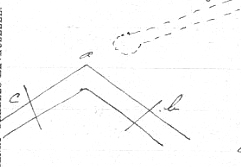
At 1400 hrs, before three companies of 3 Bat. General Deville (84 BI) awards the Croix de Chevalier de la Legion d'Honneur to Capitaine Clémendot (commanding 9 Co.) and Sous-Lieutenant (Mercier de) Sainte-Croix (commanding 5 Co.). In the afternoon, the 151 RI is informed that it's companies in the first line will be relieved at 1500 hrs by the 19 BCP and it's companies in the second line by the 8 BCP.
At the time when this relief is to take place however, the Germans launch a strong attack on the neighboring sector to the right. One of the relieving companies [of 8 BCP] is sent to intervene in this sector. the relief will not be carried out until 2000 hrs and only partially: 1, 2, 3, 4, 5, 6, 7, and 8 Cos. are successively rotated out of the trenches and directed to La Harazée to their billets. The 151 leaves to the 19 BCP disposition the material of one machine-gun section (4 Section) and the material and personnel of another (3 Section). At night, 9 Co. is replaced in the second and third lines by 4 Co. because the company of 8 BCP is still needed in the neighboring sector. 3 Bat. departs La Harazée to move to Florent, leaving behind 12 Co. as security. Médecin Aide-Major Crauste is transferred into the 151 RI. Losses for the regiment on 21 January are 3 killed and 3 wounded. The casualties recorded in the JMO include:
Killed: Sdts. Ponte (Oscar), Lefèvre (Gaston - 06472), Lagache.
Wounded: Sdts. Laurent, (Armand), Lefèvre (Charles - 015983), Lefèvre (Marcel - 9412).
Trench map of Bois de la Gruerie in the Argonne Forest dated October 1916, with French trenches in red and German trenches in blue. Note that the possession and development of the trench systems in 1915 were different from what's show here. Nonetheless, the maps provide a level of detail that illustrates the topography and some of the same trench lines occupied by the 151 RI in 1915. Source: JMO of 41 DI: 26 N 340/2 page 197.


22-24 January: The regiment leaves behind the personnel of the 4 Machine-Gun Section at La Harazée for the defense of the village. 3 Bat. (less 12 Co.) arrives at Florent at 0600 hrs where it receives its reinforcements. 1 and 2 Bats. leave La Harazée at 0630 hrs and is directed to Florent. En route, 1 Bat. (less 4 Co. under Sous-Lieutenant Vincent, whose men call him "Gros Noir") by orders of the Division General is stopped at la Croix Gentin in the position of high alert. The Germans have again attacked the central sector at works known as Marie-Elérèse and taken it.
2 Bat. arrives at Florent where it receives orders to keep itself ready to leave as soon as it incorporates its reinforcements. 3 Bat. is also alerted to be ready to depart. During the night, 19 BCP has retaken the salient angle of the trench lost by 7 Co. 1 Bat. receives orders at 1800 hrs to go occupy its billets at Florent, where it will arrive at 1930 hrs. The Médecin Aide-Major Godart leaves the regiment and goes to the Ambulance 1/6.
On 23 January at 0100 hrs, Colonel Dillemann receives orders to: 1) send one battalion to La Harazée to be there by 0600 hrs -- he'll send 3 Bat. (Commandant Vaudescal); 2) send to la Croix Gentin by 0800 hrs another battalion -- he'll send 2 Bat. (Commandant Debieuvre); 3) hasten the incorporation of reinforcements of 1 Bat. (Commandant Segonne). This operation begins at 0700 hrs and is finished only when 4 Co. (Sous-Lieutenant "Gros Noir" Vincent) that had been left in the trenches, arrives at 1700 hrs. 3 Bat. remains at La Harazée and 2 Bat. enters Florent at 1930 hrs to billet. In the evening, 9 and 11 Cos. go up to the trenches, with the 9 Co. taking up positions on la Sapinière and the 11 Co. a new trench created on the southern flank of the Ravin Sec ("Dry Ravine"). A final note: M. de Rancourt de Minérand, reserve battalion commander of the 296 RI arrives at the regiment, is evacuated 24 January.
The next day, 1 and 2 Bats. are told to make ready to march. In the evening, at 1700 hrs, the reinforcements that had yet to be incorporated into 12 Co. as they had not gone to Florent are sent to La Harazée. 9 Co. engages in fighting against German pioneers who were working to lengthen the trenches taken on 21 January from 7 Co. Losses for the regiment on 24 January are 5 killed and 21 wounded, all in 10 and 11 Cos. The casualties recorded in the JMO include:
Killed: Cap. Avot (Ernest); Sdts. Mafille, Carbonnelle, Fievet, Godou.
Wounded: Sgts. Chérifel (Gustave), Philippou, Dehayes; Cap. Palaud, Cuvelier; Sdts. Mériquet, Bonnefin, Abien, Libelin (Florian), Tardoux (Noël), Sécherot, Wagnen, Leclercq, Reguier (sp?), Roux, Lapeyre, Lenand (Antoine), Roussel, Lacquet, Taussole, Royer (Noël).
From left to right: village of La Harazée before the war looking north (the front lines will begin just beyond the wooded hills); looking south over the village; looking east to the chapel; shelters built into the reverse slope near the village.
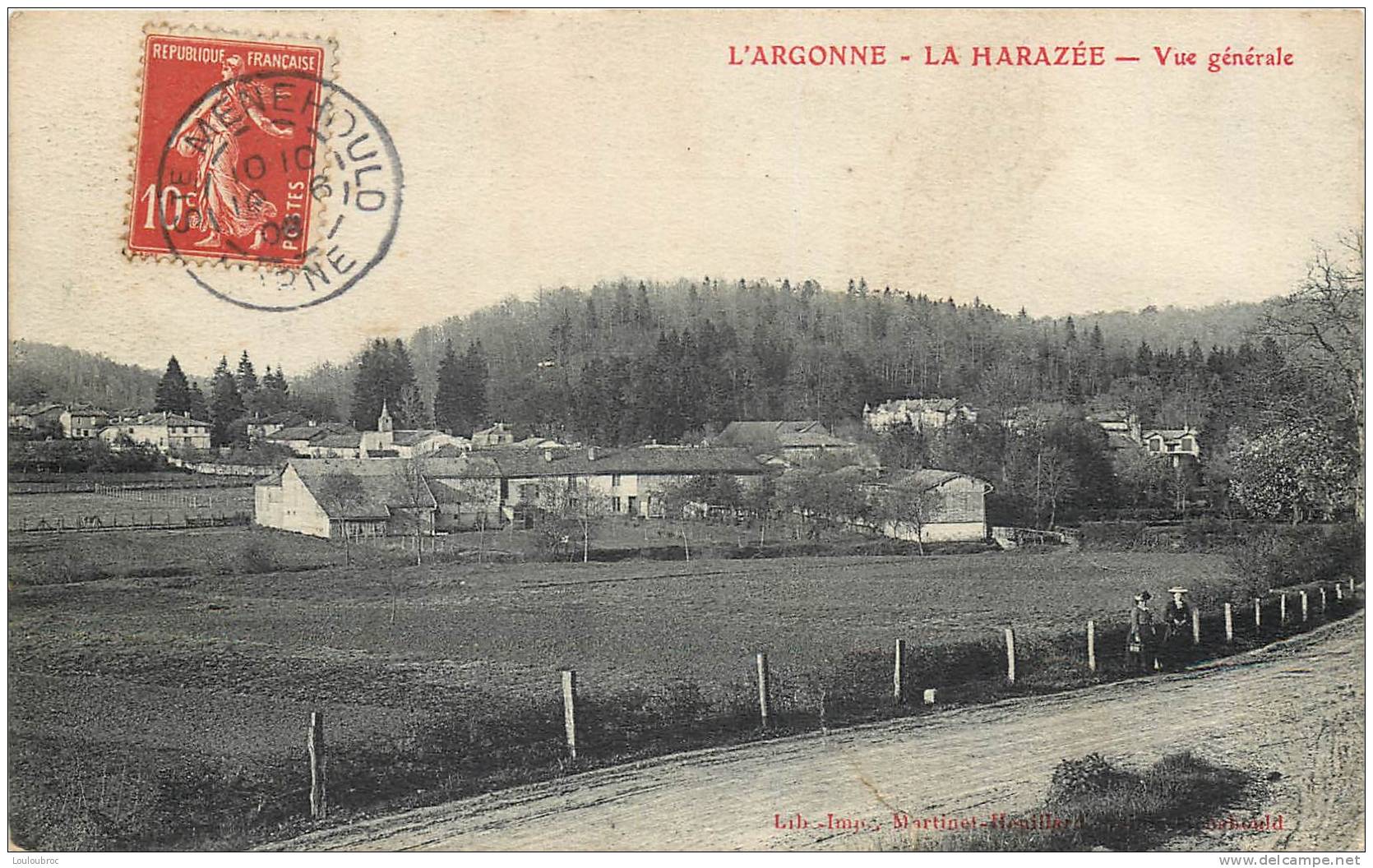
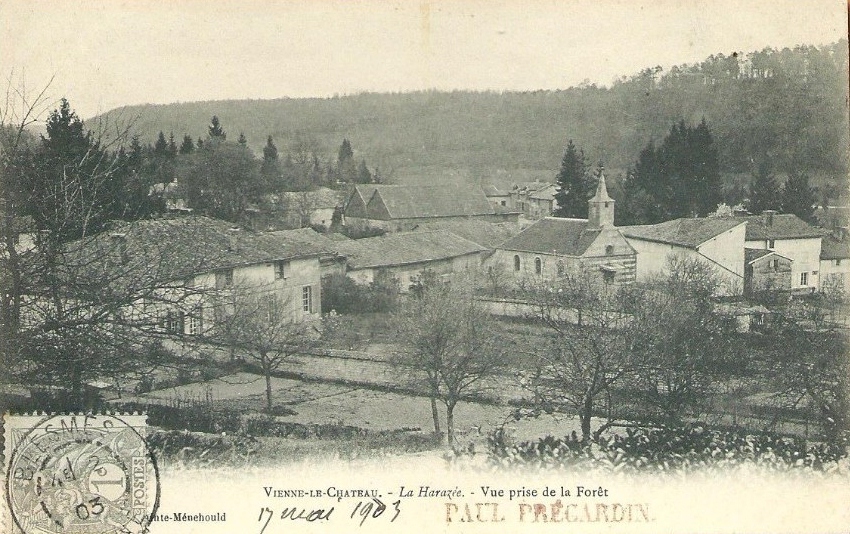
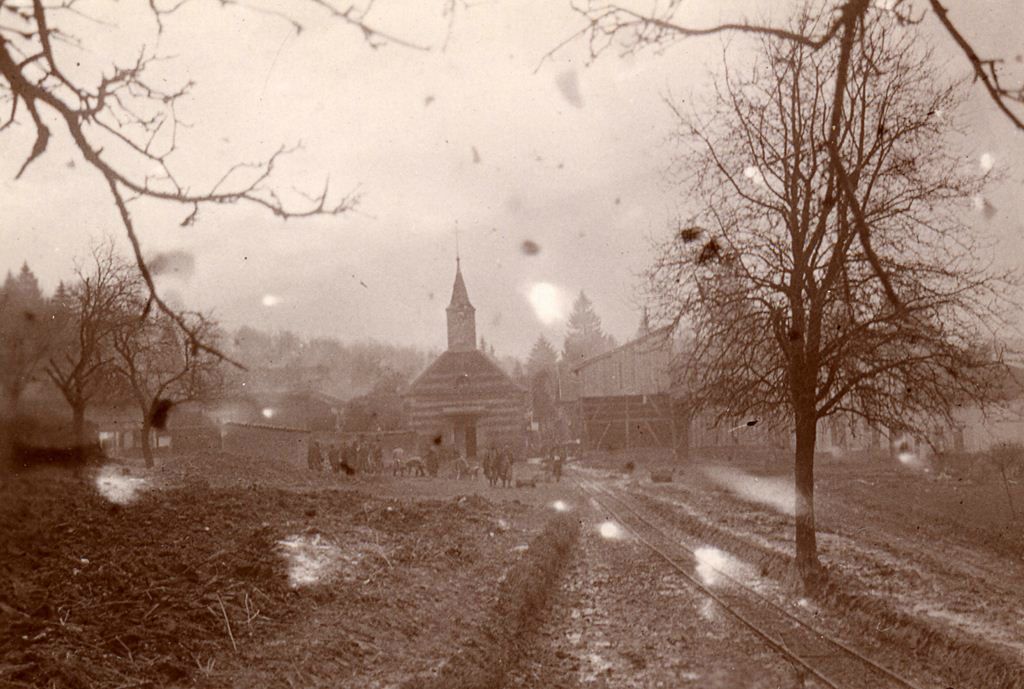

25 January: German troops bombard the trenches of 11 Co. with bombs and grenades, especially at their southern extremity. One of their minenwerfer throws a projectile that collapses one of the dugouts, burying Sous-Lieutenant Jules Boileau alive, killing 5 men and wounding another. The losses for 11 Co. alone total 32 killed and wounded.
During the night, efforts are made to recover the buried bodies but Sous-Lieutenant Boileau can't be found. One of the wounded expressed the opinion that Boileau survived the explosion but was completely dazed and headed off toward the German trenches. Boileau was never seen again and after the war was pronounced dead. (Post-war records show that Sous-Lieutenant Jules Boileau was never seen again and was subsequently presumed dead.)
1 and 2 Bats. arrive at La Harazée in the afternoon. 2 Bat. is sent into the central sector of Fontaine-Madame and occupies Enfants-Perdus and Blanleuil, and the second line. 3 Bat. occupies la Sapinière, Ravin Sec, and the third line. 12 Co. leaves La Harazée and goes into the third line. Light fighting is done in the first lines. Sous-Lieutenant Cavalier [alt. Cavailher] of 4 Tirailleurs is assigned to the 151 RI. Sous-Lieutenant Antoine and Sous-Lieutenant Ménage are made acting reserve lieutenants.
Killed: Sous-Lieuteant Boileau; Sgt.-Major Siegel (Constant); Sdts. Aubry, Sallot, Cochet, Condray, Legrand, Lamotte, Maun, Fontaine, Lefevre (Victor - 9196), Pruvot.
Wounded: Cap. Castreul, Lafaux; Sdts. Beutz, Boullet, Watrin, Petitjean, Rouzeau, Monteil, Lamonneric, Delqutte, Lefébvre (Gaston - 9412), Lefébvre (Auguste - 9184), Lefébvre (Jean - 9182), Lefébvre (Louis - 95), Tisseraud, Potte, Troiffard (Marcel), Legouy (Camille), Boin, Potard, Besse, Lambert, Dufour, Carlier (Arnould), Denizoux, Wuillenner, Prévoet, Bigolt, Roulet, Delville.
Grave of Sergent-Major Constat (Constant) Victor Siegel, La Harazée Cemetery. Born in Paris (18e Arrd.), Class of 1907, recruited at Reims.
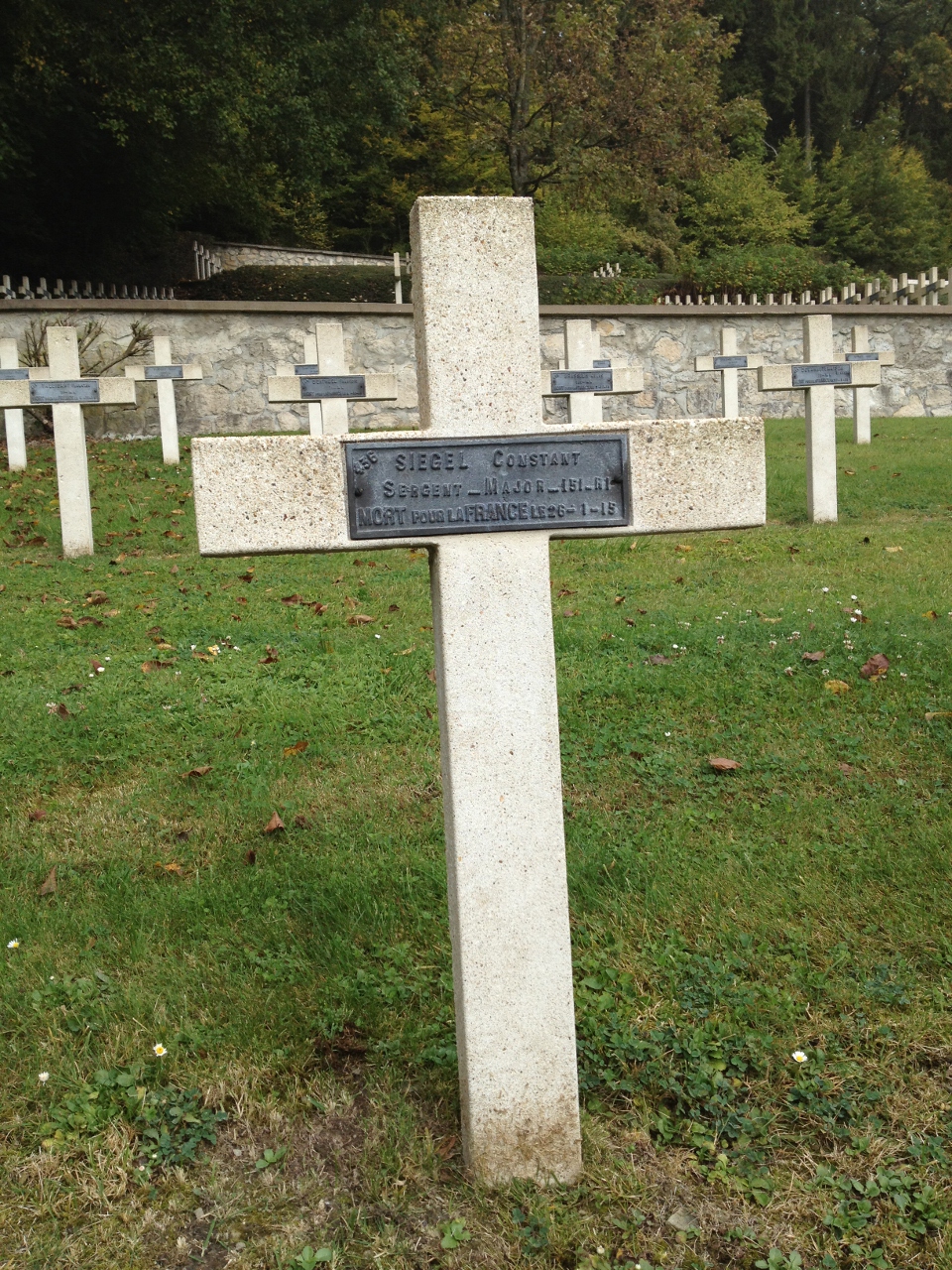
26 January: Four officers previously evacuated rejoin the unit: Lieutenant Bonnet, Lieutenant Huvet (flag-bearer), Lieutenant Wibaux, and Lieutenant Antoine. Meanwhile, German mortars and bombs continue to rain down on the regiment. Reliefs are carried out within the lines. Same disposition for all troops except for 4 Co., which moves to the second lines at la Sapinière by permutation with 9 Co. The 12 Co. relieves 11 Co. The 2 Bat. takes up positions in central sector. Losses for the regiment on this day are 4 killed and 54 wounded, most in 9 and 10 Cos. The casualties recorded in the JMO include:
Killed: Cap. Dufrenne; Sdts. Clément, Vancoolleghen, Albert, Trémel.
Wounded: Sous-Lieutenant Couplet; Sgts. Martaroche, Rémy (Lucien); Caps. Georges, Dubrant (Alexis), Verbuyste; Sdts. Dufour, Blaasner, Thévenotz (sp?), Magnol, Maqnac, Kymp, Bégly, Galan, Graffte, Virot, Lorillon, Broecq, Bétencourt, Demcy, Bousquet, Bernard, Toubert, Rey, Tremel, Pruvost (Jean), Pédro (Férnand), Beauvillers, Mérignac, Bonladon, Leenkneckt (Gaspard), Renard, Fabre, Godard (Raphaël), Vignac (Augustin), Foconie (sp?), Hubery, Jacquemin, Boisbinen, Armand, Choppelet, Burean, Joano, Prado, Champeyrol, Buisson, Blondeau, Laleux, Paulliac, Bonnefou, Larette, Goubrier, Hebert, Philippot (Emile), Eugène.
27-30 January: 10 Co., holding the Ravin Sec to the north and having suffered heavy losses, is relieved by a squadron of troopers from the 5 Chasseurs d'Afrique (a pied) and goes to rest at La Harazée. In the afternoon, 4 Co. (at la Sapinière) is attacked by German forces. 11 Co. is ordered to send a platoon to reinforce it. The 1st half-section sends a squad to assist until nightfall. At that time, 2 Co. (Enfants-Perdus) reinforces it with a section. The 4 Co. at la Sapinière is hit hard and in bad shape. The PC of the sector commander (Colonel Dillemann) is also bombarded and a direct hit from a shell destroys it. In the central sector, 7 and 8 Cos. companies move up closer to the German trenches and also are heavily engaged. Losses for the regiment on this day include 6 killed and 40 wounded. The casualties recorded in the JMO include:
Killed: Sgt. Kusberg; Cap. Léger; Sdts. Sainsonnet, Hulot, Chevalier (Férand Théophile), Manchaussat.
Wounded: Adjudant Texier (Férnand Roland); Sgt. Férlin; Cap. Lambert (Fabien); Sdts. Pérols [will die of his wounds two days later], Courcelle, Faidherbe, Peynot, Aubert, Banchat, Silbon (Vital), Macary, Evrard, Mennier, Fleury, Meyzric (Rigot), Lucien, Burguin (Miguier), Perumal (sp?), Vaungot, Trény, Jarrigeon, Lebrant, Le Chevillier (Jaochim), Aupy, Métayer, Soclron, Liendard, Chabrier, Huleux, Ponchain, Loyot, Patte, Rouley, Julle, Alexandre, Lecontre, Maltere.
The next day, 4 Co. goes to Blanleuil and is replaced at la Sapinière by 1 Co. under the orders of Lieutenant Bonnet who'd be reassigned from 10 Co. to 1 Co. as Capitaine Chamaillard is off on a special mission. The platoon of the 11 Co. which had gone to reinforce 4 Co. the evening before goes off to rest at La Harazée. Remaining in the first line is 1, 2, 3, 4 and 12 Cos. In the second line was half of 9 Co. and half of 11 Co. and in the third line was half of 9 Co. At night, a section of 6 Co. takes over a German sap with some bombers. One sergent and six men attempt in vain to take a machine-gun at night, taking losses in the act. Losses for the regiment on 28 January include 3 killed and 19 wounded. The casualties recorded in the JMO include:
Killed: Sdts. Colombier (Etienne), Koch, Lantoine.
Wounded: Cap. Herry; Sdts. Deloffre, Rekenbock, Sandron (Maximilien), Lefoulon, Odin, Damlo, Rioult, Ledauphin, Bazeut, Citern (CHR), Fontbertasse, Chantre, Vauderpoilden (Bruno), Lechien, Delacourt, Chassing, Delcroix, Campion.
On 29 January, large German attacks are launched in the sector of the 40 DI to the left (west) of the 42 DI. The troops which were to relieve the 151 are instead sent to 40 DI. There is little enemy activity in the Fontaine-Madame sector however in the central sector, the Germans launch an attack on the positions of 2 Bat. with firing dying down only at the end of the night. Losses for the regiment on this day include 9 killed, 38 wounded, and 6 missing. The casualties recorded in the JMO include:
Killed: Caps. Garenne, Moreau (Paul Honoré); Sdts. Bouillon, Lajoste (Fidele), Gallet, Capeaumont, Noyanne, Varoqueaux, Funchart (sp?), Wannecque.
Wounded: Cap. Lambert (Louis Hypplyte); Sdts. Delatte, Rousseau (Louis), Villemont, Gravier, Hanchelin, Marmonteil (Sylvain), Fouret, Montaricourt, Cambray (Robert Arsène), Guérin, Virgier, Ferloni, Brand, Normandin, Geay, Chamani, Parisse, Doujour, Sassaya, Muisi, Desclinger, Dolon, Féraux, Férrez, Violle, Bataille (Victor), Gros, Brasselet (Anatole), Routier, Fivey, Varulas, Lheiné, Ballais, Mary, Lesage.
Missing: Cap. Périat; Leroy (Pascal), Loire, Dlusiège (sp?), Raby, Lefevert.
On 30 January, 3 Bat. is replaced by 1 Bat/94 RI and goes to rest at La Harazée. German artillery continues to bombard 2 Bat. positions do not attack with infantry. 1 Bat. changes its positions. The Fontaine-Madame sector is reorganized into two sectors, north and east, and 1 Bat. cedes the original left sub-sector to 40 DI.
The north sub-sector includes in the first line la Sapinière and Enfants-Perdus; in the second line, the entire length of the barricade in the valley on the right bank up to start of the slope. The east sub-sector (occupied by 1 Bat.) includes Blanleuil (two companies) and Ravin Sec (two companies). Losses for the regiment on this day include 4 killed and 10 wounded. The casualties recorded in the JMO include:
Killed: Sdts. Latour (Alphonse César), Riché, Nolsailac (Marcolin), Bruiguier.
Wounded: Aide-Médecin Leroy; Adjudant-Chef Comtry; Cuveyller (sp?); Cap. Bonquet (Florentin), Tringand, Asse. Legrand (René), Talle, Lebrun.
In the regiment's first two weeks in the trenches of "Slaughter Wood" it loses over 300 men. It has been a nerve-wracking experience, as the companies have been under fire almost continuously from German artillery, mortars, grenades, and small-arms, as well as enduring several attacks by German infantry. 31 January: At 0900 hrs, 3 Bat. is sent to Florent. The 2 Bat. is attacked by German infantry. It's reinforced by three companies of 16 BCP. In the evening, 2 Bat. is sent to La Harazée in reserve, and from there to Florent. 1 Bat. is relieved by 3 Bat/162 RI and moves back to La Harazée. The regiment has spent nearly two weeks at the front, losing over 300 men. It has been a nerve-wracking experience, as the men have been under fire almost continuously from German artillery, mortars, grenades, and small-arms. Several times is had also been attacked by German infantry. For the time being, Colonel Dillemann remains in command of the sector. Losses for the regiment on 31 January are 3 wounded (Sdts. Heymann, Thiébault, Lemoine).
The 151 had suffered casualties nearly every day in its two weeks on the line in January; on average, 6 were killed and 27 wounded per day. In total some 320 men were killed or wounded between 18-31 January. Hundreds more had been evacuated from illness or frostbite. These losses were offset by the nearly 560 replacements who were incorporated into the twelve companies on 19 January. Even still, a regimental roll taken after its first two weeks in the Argonne shows only 44 officers and 1,990 men present for duty. This figure represents a snapshot in time. From then on, the total effective would constantly fluctuate over the coming months as replacement troops arrived by the hundreds, counter-balanced by the loss of these same men from combat and illness. On average, it would hover between 2,000 and 2,500. The regiment’s reprieve would be pitifully short. In the face of continued enemy attacks, the battalions were successively sent back up to the line after barely four days of rest.
1-3 February: On 1 February, 1 Bat. is sent to la Croix-Gentin. Colonel Dillemann is replaced by Lieut-Colonel de Saintenac of the 94 RI, but is invited to remain at La Harazée as the German attacks in the sector remain serious enough. Losses for the regiment on this day, 1 missing (Sdt. Gamez (Pierre). For reference, a divisional report on 2 February recorded that the 151 had on its rolls 34 officers and 1,685 men (with 3 officers and 44 men evacuated for illness, an important feature that should always be taken into account as these are not counted among the casualties).
The following morning, Colonel Dillemann and staff move to Florent. 3 Bat. returns to La Harazée, 1 Bat. remains at la Croix Gentin, and 2 Bat. is at Florent. The regiment is afforded only a short reprieve. On the morning of 3 February, 2 Bat. leaves Florent for La Harazée, with the troops baggage being loaded onto the artillery supply wagons. After arriving in the village, 2 Bat. moves back up to the left sub-sector of Fontaine-Madame. 1 Bat. leaves la Croix Gentin at 1400 hrs for La Harazée.
4-11 February: Colonel Dillemann and staff move back to La Harazée. 3 Bat. goes back up to the trenches in the central sector. 1 Bat. remains in reserve at La Harazée. 2 Bat. carries out a raid against a German blockhouse (pillbox) built in a part of the old French first line abandoned by 40 DI. The raid proves unsuccessful and only serves to prove that the Germans hold the works in force. Losses for the regiment on 4 February are 1 killed and 11 wounded (including Sgt. Pierrain, Sdt. Pamillon).
On 5 February, 1 Bat. goes up to the trenches and takes up the right sub-sector of Fontaine-Madame. A study is undertaken on the best way to carry out an attack on the Blanleuil hillock and works, which is to be undertaken the next day. German mortars remain active and continue to cause daily losses in the 151 ranks. A reporting change is made so that the machine-gun sections in the trenches no longer report to the regimental commander but to Commandant Moisson of the 162 RI and billets major of La Harazée. Consequently, they become dependent on the needs of the sector. Losses for the regiment on 5 February are 11 killed and 12 wounded, most in 2 Bat. The casualties recorded in the JMO include:
Killed: Lieutenant Dartiglongue (Henri); Sgts. Martin (Maurice), Brémard (Arthur), Sérizier; Cap. Allard; Sdts. Versost, Vial (Auguste), Tourou, Debursa, Puissau, Flament.
Wounded: Sgts. Bérard, Desaulty; Sdts. Laurent, Dagnigne, Bataille, Ruis, Guinez, Sarazin, Lachaise, Boisuard, Petit (Abel), Carbonnet.
On 6 February, 3 Bat. moves up to the trenches. In the evening of 5-6 Feb., a 65mm gun (mountain-howitzer) must be placed on the right bank of the Fontaine-Madame, intended for use in the destruction of the German blockhouse threatening the French first line in la Sapinière and Enfants-Perdus. In the event, the gun destroys a German dugout. Troops in 2 Bat. are given the assignment of removing the shoulder insignia off the dead Germans in the shelter but are unable to carry it out as the blockhouse is too well guarded. Losses for the regiment this day are 2 killed and 12 wounded, most in 2 Bat. The casualties recorded in the JMO include:
Killed: Sdts. Miou (Aloide), Vinceaux.
Wounded: Sgt. Huppin; Cap. Dupuis (Antoine); Sdts. Chard, Debray, Dicquelou, Malbranque (Augustin), Courty, Lascoux, Manager, Clavard, Parmentier.
The next day, no further operations are carried out but German artillery and mortar fire reap more destruction. Losses for the regiment on 7 February are 8 killed and 26 wounded, most in 2 Bat. The casualties recorded in the JMO include:
Killed: Sgts. Mercier (Adelson), Crombez (Albert); Cap. Franchomme; Sdts. Elby, Hubert, Soulard, Dicquelou (Audry).
Wounded: Sgts. Hupin, Robert; Cap. Faillu; Sdts. Bosseboeuf (Henri), Jacquemin, Collet, Lemaire, Hautcolas, Bagney, Contant, Goutier, Teillet, Miconne, Mouge, Lemaire (Francois), Faye, Vion, Verdier, Odoux, Barbier, Spies, Alexandre, Char, Champagnac, Debray, Pessane.
On 8 February, no further operations. At night, 3 Bat. (Commandant Vaudescal) is relieved and puts two companies on the line 'IN' of the central sub-sector and two companies with the regimental staff at La Harazée. The 2 Bat. (Commandant Debieuvre) is also relieved moves back to La Harazée. The 1 Bat. (Commandant Segonne) continues to hold the right sub-sector of Fontaine-Madame. Losses for the regiment on 8 February are 6 killed and 15 wounded. The casualties recorded in the JMO include:
Killed: Sdts. Duriez, Bourreau, Guillé, Montou, David (Férnand), Julle.
Wounded: Sgt-Fourrier Dechaume; Sgts. Barbet, Pluquet; Cap. Bouilly; Sdts. Battermann, Berlimont, Boimiout (sp?), Olmis (sp?), Jubé, Texier, Girandeau, Chaplin, Séguin, Fînet.
On 9 February, 2 and 3 Bats. are sent to Florent for rest. The 1 Bat. is also relieves and moves back to La Harazée. Colonel Dillemann passes command of the Fontaine-Madame sub-sector to Lieut-Colonel de Saintenac of the 94 RI. The next day, 1 Bat. marches to Florent. A detachment of reinforcements arrives at Florent composed 3 officers and 811 men, consisting of:
Capitaine Gillet (who'd been evacuated and comes from the 151 depot)
Sous-Lieutenant Guelfucci (coming from 25 RI)
2 aspirants
1 adjudant
1 sergent-fourrier
14 sergents
21 caporaux
716 veteran soldiers
58 new recruits
These replacements come from the following units:
330 from 151 RI
70 men from 25 RI (Cherbourg/Saint Vaast-La-Hougue)
61 men from 41 RI (Rennes)
71 men from 47 RI (Saint-Servan/Saint-Malo)
89 men from 48 RI (Guingamp)
71 men from 70 RI (Vitré)
40 men from 71 RI (Saint-Brieuc)
51 from 106 RI (Chalons-sur-Marne)
30 from 132 RI (Reims)
These reinforcements are incorporated into the three battalions of the regiment. At 1400 hrs, 3 Bat. is order to go to la Croix Gentin to be at the disposition of the division commander. It leaves after just having its reinforcements incorporated into the companies.
12-16 February: Colonel Dillemann is ordered to retake command of the Fontaine-Madame sector. 1 and 3 Bats. move back up to the trenches, taking over the right and left sub-sectors of Fontaine-Madame, respectively. The 2 Bat. remains at Florent for the time being. The next day 1 and 3 Bats. are to take part in an attack on Blanleuil, but around 1500 hrs the Germans begin pounding the French positions with so many bombs that the damage being caused forces the attack to be pushed back to allow the French lines to be repaired. Losses for the regiment on 12 February are 1 killed (Sdt. Lehuedé) and 1 wounded (Sgt. Ladouce).
The next day, 2 Bat. marches to La Harazée and in the evening moves up to the central sub-sector, relieving the 5 Bat/328 RIR. Losses for the regiment on 13 February are 12 wounded (Sgt. Desailly; Cap. Admirand; Sdts. Lefebvre (Louis Auguste - 9433), Marais, Hermann, Barjonnet, Reigoter, Deporteu, Chérat, Pioche, Bargués, Schmidling).
On 14 February, the only movement is the reliefs conducted between the companies, as German bombs continue to cause daily losses and wrack the nerves of the men. The following men are cited in the Orders of the Army: Sgts. Barbet and Jauget (6 Co.), Sgt. Gast (11 Co.), Sdt. Carlier (9 Co.), Stretcher-Bearers Fontaine, Hubert (Léon), Hubert (Fernand), Louby. Losses for the regiment on this day are 2 killed (Sdt. Leclerc (Louis - 7229) and Dragonne (Norbert)) and 8 wounded (Caps. Asselin, Picart; Sdts. Laleu, Serrain, Percevaux, Bataille (Joseph), Deregnaucourt.)
On 15 February, a mountain-howitzer is installed at Blanleuil on the slope overlooking the Ravine of Fontaine-auc-Charmes. 1 Bat. (Segonne) is relieved by 5 Bat/328 RIR and goes to billets in the evening at La Harazée. 2 Bat. carries out a reconnaissance to find a German blockhouse suspected to be in front of 8 Co.'s front, which is subsequently determined to not exist. Losses for the regiment on this day are 4 killed (Sdts. Peynichoux, Dillac, Delagrange, Lacherest) and 12 wounded (Sgt. Bienaimé; Sdts. Soufflet, Després, Venet, Cattiaux, Domise, Fanouillere, Hermel, Lefevre, Mary, Leclerc (Jules), Bessière).
In the evening of 16 February, 3 Bat. is relieved by 3 Bat/162 RI and moves back to La Harazée. All plans are put on hold in anticipation of an attack on Blanleuil to take place the following day. Capt. Cavaillier is cited in the Orders of the Army. Four new officers arrive to the regiment:
Lieutenant Barnier coming from the 287 RI
Lieutenant Malaudain coming from the 118 RI
Sous-Lieutenant Lancelot coming from the 351 RI
Sous-Lieutenant Deprat coming from the 151 RI
Losses for the day include 4 killed (Sdts. Blanchet, Lefévre, Marie, Janaunex [sp?]), 12 wounded (Sgt. Mavier; Sdts. Despres, Le Barba, Dumortier, Tremel), 1 missing (Sdt. Dubois). For reference, a divisional report the next day recorded that the 151 had on its rolls 36 officers and 2,190 men.
On 17 February: At 0800 hrs, Commandant Segonne (1 Bat.) orders for three mine shafts dug under the sides and center of the Blaneuil works to be set off, then has the German trenches bombarded with 58 mm mortars. At 0810 hrs, Segonne launches his attack on the German position. Two companies of the 16 BCP move up to take it. By 0900 hrs, the trench is in French hands. Successively, 3 and 4 Cos. of the 151 RI moves up to reinforce the line and consolidate the retaken positions.
Yet beginning at 1230 hrs the conquered positions are submitted to a German bombardment of 105 shells and other light shells before being taken in enfilade by fire from two machine-guns. In the trench is a German machine-gun whose entire crew had been killed and wounded by the chasseurs. Two men from 3 C., Sgt. Hiolet and Sdt. Lefévre, manage to get the gun up and working and return fire.
[Soon after] the conquered positions are submitted to a bombardment of 105 shells and other light shells before being taken in enfilade by fire from two machine-guns. In the trench is a German machine-gun whose entire crew had been killed and wounded by the chasseurs. Two men from 3 Co. manage to get the gun up and working and return fire. At 1430 hrs, the Germans bombard the line and execute along the entire front an attack, which kills and wounds almost great number of chasseurs of the 16 BCP (250 out of 400), 193 men of the 151 RI, and 100 more men from the "normal garrison of the works" (328 RI). One of those killed is Commandant Eugène Segonne, commanding 1 Bat. (pictured below). Segonne had been a cadet at Saint-Cyr (Promotion of Soudan), a Chevalier de la Légion d'Honneur, and a recipient of the Croix de Guerre. His death was a great loss for the regiment. Capitaine Gillet (12 Co.) will take command of 1 Bat. in his stead.
Half an hour later, the position is entirely retaken. Counter-attacks are immediately ordered but prove unsuccessful. During the course of these counter-attacks, 6 Co. (to the left of 2 Bat, in the central sector) momentarily intervenes on the flank of the German attack but is quickly paralyzed by the fire of German machine-guns. Meanwhile, 3 Bat. is pushed up as reinforcement in the second, third, and line 'IN'.
The 1 Bat. spends the night at Blanleuil. 3 Bat. remains in reserve, with 11 Co. in the 3rd line, 9 Co. and two platoons from 10 Co. on line 'IN', 12 Co. and two platoons from 10 Co. at La Harazée. The 2 Bat. remains in the central sector. Losses for the regiment on this day include 15 killed, 99 wounded, 44 missing; a total of 158 suffered mostly in 1, 3 and 4 Cos. The casualties recorded in the JMO include:
Killed: Commandant Segonne (Eugène); Sous-Lieuteant Istria (Simon Ange); Sgt. Lefévre (Edmond); Cap. Herkaert; Sdts. Condert, Coquin, Carteron, Brunet, Didier, Le Guerunec, Houzé, Juisson, Legros, Peltriaux, Lefévre (Arthur Louis).
Wounded: .
Missing: .
18 February: At 1000 hrs, new orders are issued to assault Blanleuil again at 1600 hrs, to be carried out successively by 1, 2, and 3 Cos., followed by 11 and 9 Cos. A strong preparatory barrage is to precede the attack at 1500 hrs, consisting of 58 mm mortars, Cellerier mortars, and hand-bombs (pétards). Yet at 1300 hrs, orders arrive instructing that the infantry should be sent into the attack if the artillery preparation is sufficient, if success can be assured and if losses are anticipated to be light.
At 1610 hrs, two attacks are launched at either end of the Blanleuil works. Every NCO and soldier who attempts to go over the top are immediately either killed or wounded. Clearly the preparations were not sufficient. In light of these results, the attacks are immediately called off. The German positions are bombarded until midnight.
The 2 Bat. in the central sector is harassed along its front and receives mortar fire, to which it responds in kind. At 1830 hrs, 3 Bat. (Comm. Vaudescal) is relieved in the supporting lines and sent back to Florent, followed three hours later by 3 and 4 Cos. The 1 and 2 Cos. remain in place to defend and reorganize their positions. Numerous commendations are proposed to reward those who conducted themselves well on this day and the day before. Lieutenant Martin arrives from the 65 R and Mr. Sergent Médecin Aide-Major is transferred to the 328 RI.
Losses for the regiment on this day include 2 killed (Cap. Gérard and Sdt. Le Berre) and 11 wounded (Sdt. Pillot, Augry, Fayolle, Carbonnel, Morelle, Berton, Guffroy, Renaud, Derache, Evrard, Bonderlique).
19-28 February: The 1 and 2 Cos. are sent to rest at Florent, arriving at midnight. Colonel Dillemann and his staff precede these companies. As such, 1 and 3 Bats. are at rest at Florent while 2 Bat. remains in lines, actively resisting the Germans with bombs during the day. 2 Bat. will be releived in the evening by 1 Bat/94 RI, moving back to La Harazée. The unit receives two sections of Hotchkiss machine-guns. Losses for the regiment on this day include 1 killed (Sdt. Séguin) and 4 wounded (Sdts. Brunel, Leroy (Eugene), Hainant, Faucou).
1 and 3 Bats. remain at rest the next day at Florent. For 2 Bat., 5 and 8 Cos. are sent from La Harazée up to the line "IN". 7 Co. is sent up to the second line at Blanleuil while 6 Co. remains at rest at La Harazée. Losses for the regiment on 20 February include 1 killed (Sdt. Quintin) and 1 wounded (Sdt. Adouard).
On 21 February, a machine-gun company is constituted in adherence to the orders of general commanding the Groupe des Armées d l'Est (conforming to order no. 9267 of 30 Jan. 1915). At Florent, Colonel Dillemann decorates Sergent Hiolet (3 Co.) with the Médaille Militaire in recognition of his service since the start of the war, his aptitude, his courage, sangfroid, and energy displayed under fire. The same medal is also awarded to Adjudant-Chef Ottavi, Sdt. Bentz and Sdt. Lecknett. For these last two, their medals were sent to the regimental depot, as both men had been wounded and evacuated.
For 2 Bat., 5 and 6 Cos. are sent up to the line "IN", 8 Co. moves up to the second line at Blaneuil, and 7 Co. spends the day at La Harazée. Losses for the regiment on 21 February include 1 killed (Sdt. Sevrain) and 3 wounded (Sdts. Delaporte (Randolphe), Billoir, Jacquard).
On 22 February, at 0700 hrs 3 Bat. and two sections of (Hotchkiss) machine-guns leave Florent for La Harazée. In the evening it goes up to the line and takes up positions in the left sub-sector of Fontaine-Madame with two platoons in the first line, two companies in the second line, and two platoons in the third line. The 2 Bat. goes to rest at La Harazée where it reconstitutes itself.
The following day, Colonel Dillemann and his staff return to the trenches and takes command of the sub-sector. 1 Bat. goes to La Harazée save 3 Co. (Capt. Pernet) which remains at Blanleuil. Commandant Segonne is cited in the Orders of the Army. Losses for the regiment on 23 February is 1 wounded (Sdt. Macaique (Ernest Adille Ambroise)).
On 24 February, 2 Bat. (at rest at La Harazée) goes up to the line and takes up positions in the right sub-sector of Fontaine-Madame (Blanleuil and Ravin Sec). 3 Co. is sent back down to La Harazée for rest. It's found that the Germans had greatly demolished the parapets of the Blanleuil works, which must be repaired throughout the night. Two companies of 1 Bat. are put in reserve in the central sector. On this day, Capitaine Tison and Colonel Ruef are officially given their ranks. Losses for the regiment on 24 February include 4 wounded (Sgt.-Major Demolliens (André), Sdts. Brun (Rene Louis), Chanly, Robitaille). Additionally, a detachment of reinforcements arrives from the 151 depot composed of 308 men, consisting of:
1 sergent
7 caporaux
193 veterans
107 new recruits
Because the Division General believes the new recruits require additional instruction, he orders that they not yet be incorporated into the regiment.
The following day, 2 and 3 Bats. carry out interior reliefs of their units between the lines. The two companies of 1 Bat. that had been sent to the central sector are sent back to La Harazée, being relieved by another company in 1 Bat. Mr Galan is promoted Médecin Aide-Major de 1e Classe. Losses for the regiment on 25 February include 3 killed, 9 wounded, 1 missing. The casualties recorded in the JMO include:
Killed: Sdts. Hublot, Gosset, Robert (Alcide).
Wounded: Sgt. Suder; Sdts. Citté, Tirel, Salan, Frétay, Chavois, Sarcel, Roussarie, Colman.
Missing: Cap. Piot.
On 26 February, all units remain in their positions. the Germans send over more and more bombs onto Blanleuil, causing a good deal of damage. Commandant Moisson, Chef de Bataillon of the 162 RI. is assigned to the 151. Reserve lieutenants Marchand, Cuvillier, and Riton are officially conferred to the active service cadre. Caporal Lenoble (4 Co.) is awarded the Medaille Militaire. Losses for the regiment on 26 February include 8 killed and 20 wounded. The casualties recorded in the JMO include:
Killed: Sdts. Le Lamer, Rocaboy, Bricourt, Capron, Roffidal, Priguy, Salann, Durot.
Wounded: Sous-Lieut. Aubert; Adjudant Diaguin (Oscar); Caps. Péraire, Souiller (Alain); Sdts. Roix, Lalon, Buisson, Marcheras, Besnard, Bourel, Le Bonille, Lichtember, Bonhommet (Charles), Lesaicherre, Stippe, Larmet, Le Bonhris, Lecroix (Georges), Cheneveau, Pélardy.
The next day, 3 Bat. is relieved by 1 Bat. in the left sub-sector of Fontaine-Madame and goes to rest at La Harazée. 2 Bat. remains in place. Losses for the regiment on 27 February include 10 killed (including Lieut. Trouillier) and 14 wounded.
On 28 February, 2 Bat. is given orders to carry out a diversion at 0900 hrs to attract the attention of the enemy. The diversion will consist of opening a rifle fusillade and firing mortars along its entire front. There's no stated objective for this operation in the JMO. All it serves to accomplish is to provoke the Germans into firing a large number of bombs on Blanleuil and the Ravin Sec. The destructive fire further degrades the parapets of the works, which the regiment had only just repaired. The German mortar fire also proves deadly. Losses for the regiment on 28 February include 8 killed (including Sgt.-Major Becourt) and 17 wounded. For reference, a divisional report the next day recorded that the 151 had on its rolls 38 officers and 2,422 men.
The regiment suffered some 440 casualties in the month of February, including 160 on 17 February. On average 15 men were killed or wounded each day. Not included in this count are the scores of men evacuated from illness, disease, forstbite and trench foot.




